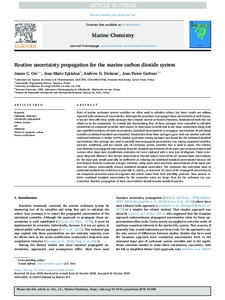| dc.contributor.author | Orr, James | |
| dc.contributor.author | Epitalon, Jean-Marie | |
| dc.contributor.author | Dickson, Andrew | |
| dc.contributor.author | Gattuso, Jean-Pierre | |
| dc.date.accessioned | 2018-11-20T14:11:27Z | |
| dc.date.available | 2018-11-20T14:11:27Z | |
| dc.date.issued | 2018 | |
| dc.identifier.citation | Orr, J. C., Epitalon, J.-M., Dickson, A. G. and Gattuso, J.-P. (2018) Routine uncertainty propagation for the marine carbon dioxide system. Marine Chemistry, 207, pp.84–107. DOI: https://doi.org/10.1016/j.marchem.2018.10.006 | en_US |
| dc.identifier.uri | http://hdl.handle.net/11329/549 | |
| dc.description.abstract | Pairs of marine carbonate system variables are often used to calculate others, but those results are seldom reported with estimates of uncertainties. Although the procedure to propagate these uncertainties is well known, it has not been offered in public packages that compute marine carbonate chemistry, fundamental tools that are relied on by the community. To remedy this shortcoming, four of these packages were expanded to calculate sensitivities of computed variables with respect to each input variable and to use those sensitivities along with user-specified estimates of input uncertainties (standard uncertainties) to propagate uncertainties of calculated variables (combined standard uncertainties). Sensitivities from these packages agree with one another and with analytical solutions to within 0.01%; similar agreement among packages was found for the combined standard uncertainties. One package was used to quantify how propagated uncertainties vary among computed variables, seawater conditions, and the chosen pair of carbonate system variables that is used as input. The relative contributions to propagated uncertainties from the standard uncertainties of the input pair of measurements and various other input data (equilibrium constants etc) were explored with a new type of diagram. These error-space diagrams illustrate that further improvement beyond today's state-of-the-art measurement uncertainties for the input pair would generally be ineffective at reducing the combined standard uncertainties because the contribution from the constants is larger. Likewise, using much more uncertain measurements of the input pair does not always substantially worsen combined standard uncertainty. The constants that contribute most to combined standard uncertainties are generally K1 and K2, as expected. Yet more of the propagated uncertainty in the computed saturation states of aragonite and calcite comes from their solubility products. Thus percent relative combined standard uncertainties for the saturation states are larger than for the carbonate ion concentration. Routine propagation of these uncertainties should become standard practice. | en_US |
| dc.language.iso | en | en_US |
| dc.subject.other | Carbonate chemistry | |
| dc.subject.other | Uncertainty propagation | |
| dc.subject.other | Carbon dioxide (CO2) | |
| dc.subject.other | pH | |
| dc.subject.other | Alkalinity | |
| dc.subject.other | Dissolved inorganic carbon | |
| dc.subject.other | Ocean acidification | |
| dc.title | Routine uncertainty propagation for the marine carbon dioxide system. | en_US |
| dc.type | Journal Contribution | en_US |
| dc.description.refereed | Refereed | en_US |
| dc.format.pagerange | pp.84-107 | en_US |
| dc.identifier.doi | https://doi.org/10.1016/j.marchem.2018.10.006 | |
| dc.subject.parameterDiscipline | Parameter Discipline - Chemical oceanography - Carbonate system | en_US |
| dc.subject.dmProcesses | Data Management Practices::Data analysis | en_US |
| dc.subject.dmProcesses | Quality control | |
| dc.rights.license | https://creativecommons.org/licenses/by-nc-nd/4.0/ | |
| dc.bibliographicCitation.title | Marine Chemistry | en_US |
| dc.bibliographicCitation.volume | 207 | en_US |
| dc.description.eov | Inorganic carbon | en_US |
| dc.description.bptype | Guide | en_US |
| obps.contact.contactemail | james.orr@lsce.ipsl.fr | |
| obps.resourceurl.publisher | https://www.sciencedirect.com/science/article/pii/S030442031830149X?via%3Dihub | en_US |
 Repository of community practices in Ocean Research, Applications and Data/Information Management
Repository of community practices in Ocean Research, Applications and Data/Information Management
